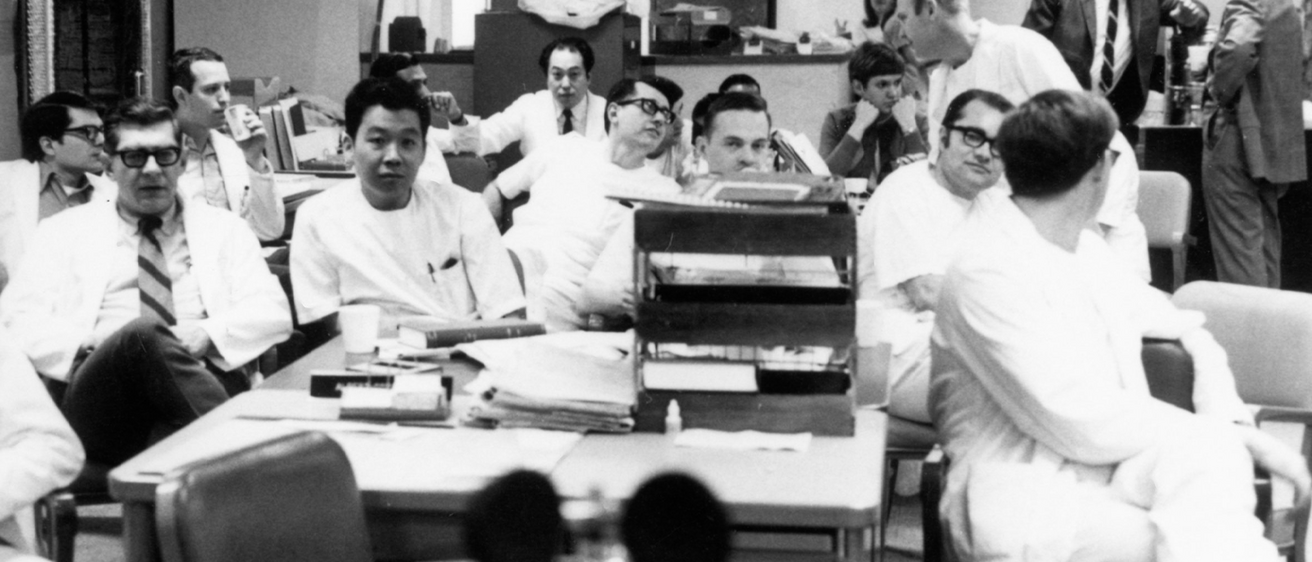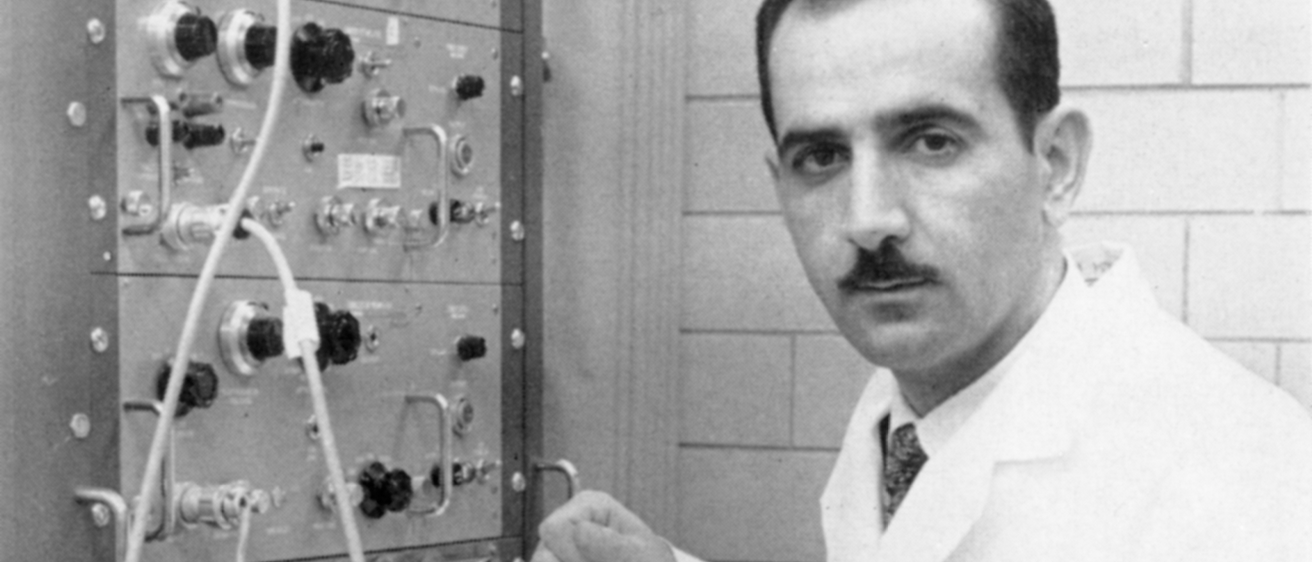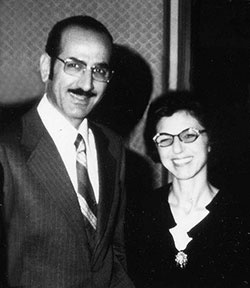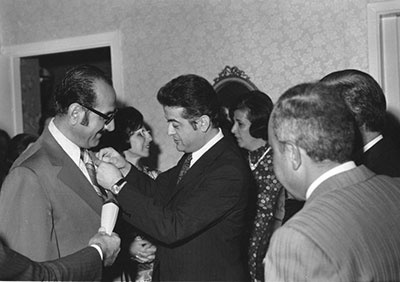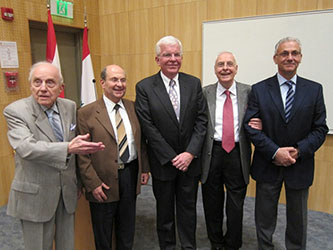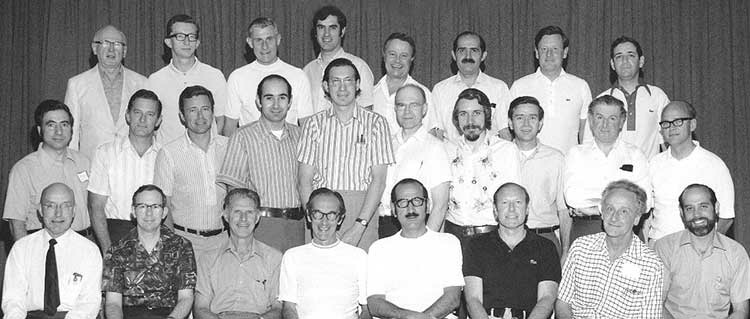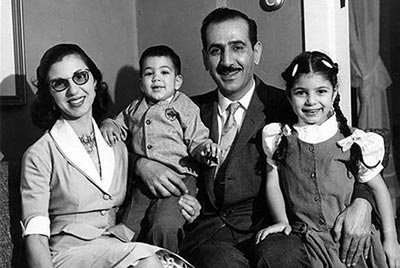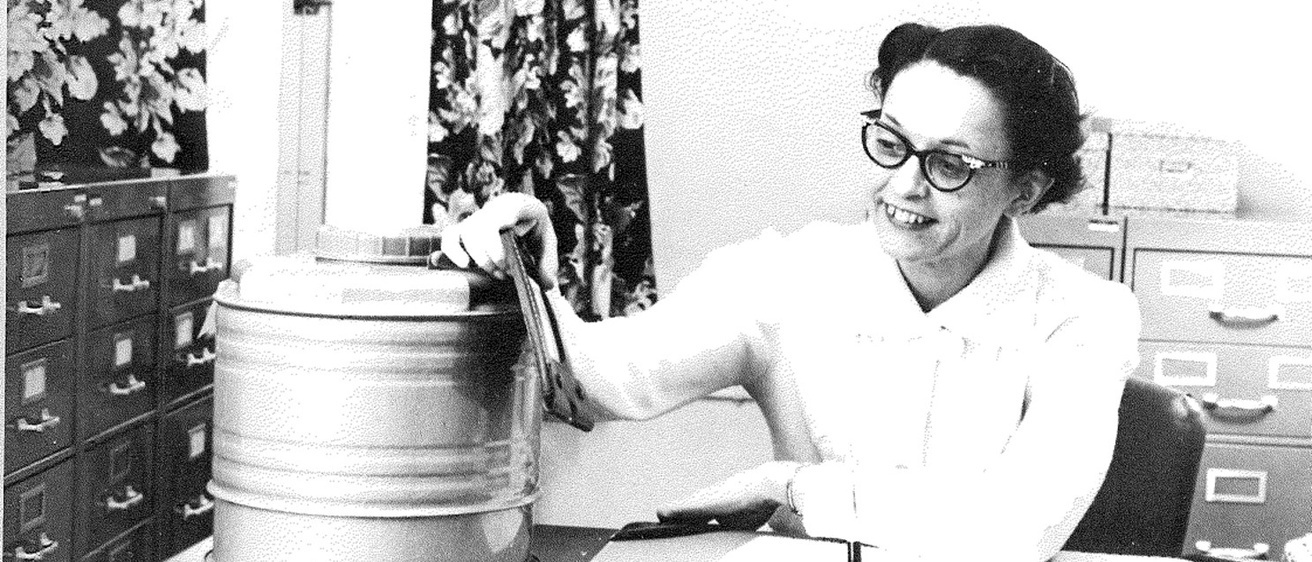Main navigation
Between 1955 and 1964, under the leadership of Dr. Alson E. Braley, the University of Iowa's Department of Ophthalmology achieved significant milestones. In 1955, Dr. Braley established the Iowa Lions Eye Bank with support from the Lions Clubs of Iowa, facilitating corneal transplants statewide. The department pioneered the use of state highway patrol officers to transport donor eyes for transplantation and later trained morticians in corneal removal to expedite the process. These innovations positioned the department as a leader in eye care and transplantation during this period.
Jump to a specific section...
Video: Dr. Braley discussing his life and work Video: Dr. John Graether, class of 1961, discusses his time at Iowa Founder of glaucoma service, Mansour F. Armaly Timeline: Eye Banking in Iowa The Early Days of Iowa Lions Eye Bank History of the Eye Bank Network Old Eye Bank Videos Videos about Eye Net
600 %
6 to 16
"I think the most important thing, as far as residents and fellows were concerned, was giving them an opportunity and time—the opportunity and time in which to develop themselves. If you drive a man too hard, he will not do anything except the necessary work. If you give him the opportunity to think and develop his own ideas, he is going to develop much farther than if you try to keep him busy every single minute."
"I have corn coming out of every ear. You can't get the corn out of an Iowan."
Dr. Braley discussing his life and work at the University of Iowa
Dr. John Graether completed his residency at Iowa in 1961
Dr. Graether discusses the department during the late 1950's and early 1960's when he was a resident. He also discusses his professional life and how his time at Iowa influenced that.
Jump to specific sections of the interview with Dr. Graether:
The Journey to Iowa ⇥ After Arriving at UI ⇥ Living in Iowa City ⇥ Grand Rounds and Faculty Support ⇥ Lessons from Residency at Iowa
During his tenure at the University of Iowa from 1955 to 1970, Dr. Mansour F. Armaly made groundbreaking contributions to the field of ophthalmology, particularly in the study of glaucoma. He arrived in Iowa City in 1955 after being awarded a two-year research fellowship. By the time his research grant had ended in 1957, he was hired as a full-time faculty member.
He established the glaucoma service at the university and was instrumental in defining the natural history of the disease. Dr. Armaly developed innovative techniques for the early detection and monitoring of glaucoma, including the use of visual fields and optic disc evaluations to detect nerve fiber damage. His work led to the identification of a normal range of intraocular pressure, which is still used today.
Dr. Armaly's research at Iowa also included the Des Moines Population Study of Glaucoma, which provided valuable data on the prevalence and characteristics of the disease. He introduced the concept of the "cup-to-disc ratio" as an indicator of optic nerve damage and developed the Armaly-Drance visual field testing pattern. His studies highlighted the genetic factors related to glaucoma, showing a significantly higher incidence in patients with a family history of the disease. Dr. Armaly's dedication to research and education left a lasting legacy, and he trained many residents and fellows who continued to advance the field of glaucoma treatment and research.
READ MORE ABOUT DR. ARMALY AND HIS IMPACT AT IOWA →
Eye Banking in Iowa in the 1950's and 1960's

Braley is First in Iowa to Perform Corneal Transplants
1953Dr. Alson E. Braley, who trained in New York City with early corneal transplant pioneer Ramon Castroviejo, returns to Iowa as chair of the University of Iowa Department of Ophthalmology. He soon performs the first corneal transplants in Iowa.
Braley Proposes Iowa Eye Bank
1954Dr. Braley sees the need for an eye bank in the Midwest and approaches the Lions Clubs of Iowa during their state convention in Fort Dodge, asking for financial support. The Lions accept the challenge to raise money for the eye bank and help ensure the passage of state legislation allowing a person to will body parts to a medical school or an eye bank in Iowa.
Video is of Dr. Braley Discussing the Lions Club in the creation of Iowa's Eye Bank

Iowa Lions Eye Bank Established
September 13, 1955Iowa Lions Eye Bank is established with $10,000 raised by the Iowa Lions Clubs. Dr. Braley becomes the first medical director. Ruth Fisher (pictured above right), a young woman from Kalona, Iowa who had two corneal transplants performed by Dr. Braley, serves as the first secretary, and later executive director of the eye bank.

State Patrol Delivers Corneas for Transplant
1955The department's doctors became the first in the nation to enlist state highway patrol officers to rush donor eyes for corneal transplantation. This innovative approach significantly improved the success rate of corneal transplants by reducing the time between donation and transplantation
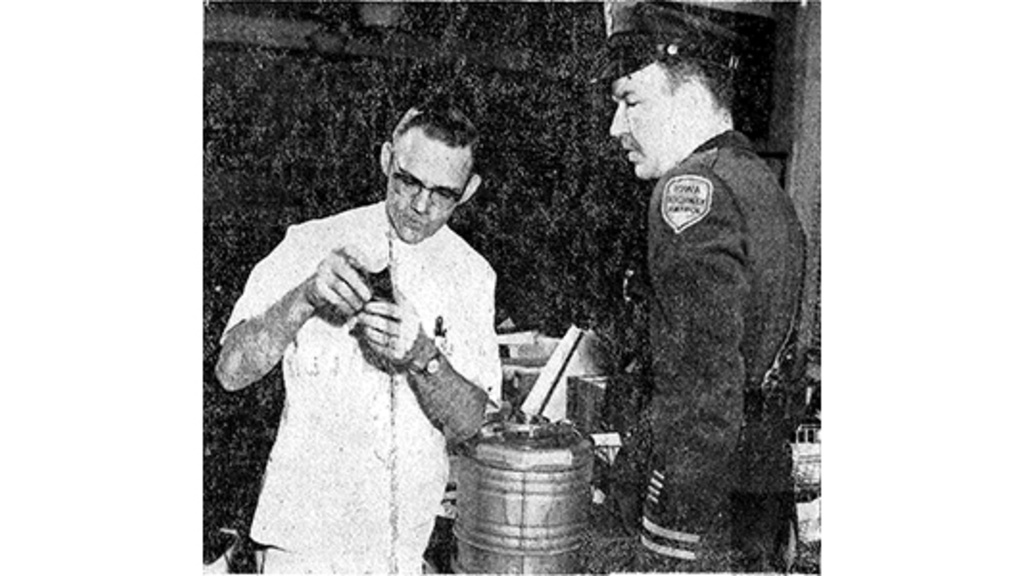
First Cornea Donation in Iowa Lions Eye Bank History
December 11, 1955Carl Oscar Pearson, 67, of Moline, passes away and his eyes are donated to Iowa Lions Eye Bank. This is the first donation in Iowa Lions Eye Bank history. The eyes are transported by Highway Patrolman Richard Reddick to University Hospital, where they are accepted by Dr. C.C. Morledge of the ophthalmology department. The next morning, Dec. 12, Dr. Braley transplants Pearson’s corneas into the eyes of Dr. Robert P. Woods, a neurosurgeon from Topeka, Kansas. This is the first transplant ever done using tissue from Iowa Lions Eye Bank.

Advances in Corneal Transplants and Training Morticians to Remove Corneas
1956-1959During this period, the department continued to advance its corneal transplantation techniques. They began training morticians to remove corneas for transplantation, which helped increase the availability of donor tissues
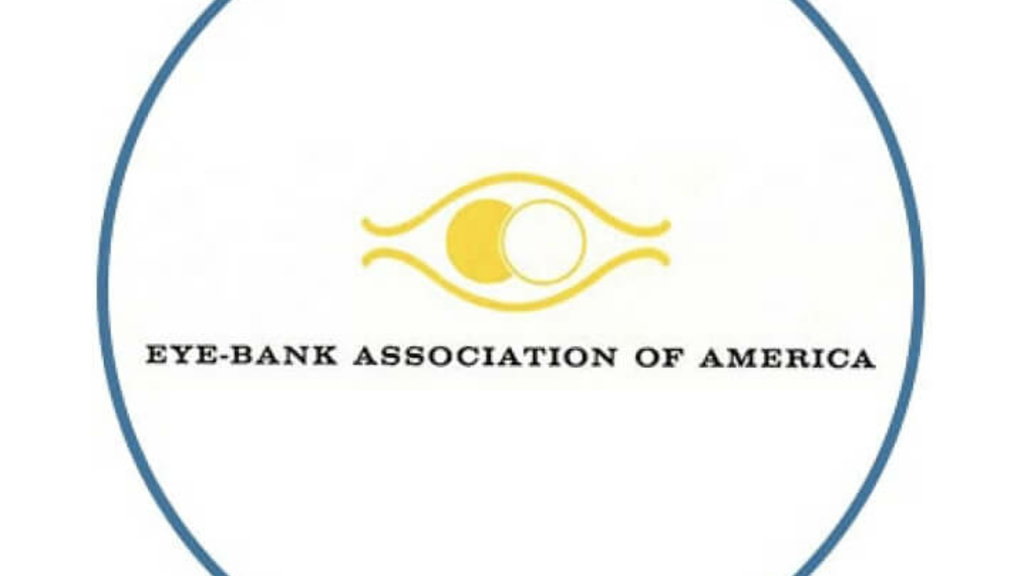
Eye Bank Association of America is Founded
1961Iowa Lions Eye Bank is one of ten founding members of the Eye Bank Association of America. (EBAA) Iowa Lions Club member Ted Hunter, one of the leaders in the founding of Iowa Lions Eye Bank, is named to the EBAA Board of Directors.
Eye Bank Network is Established
December 20, 1962Dr. Alson Braley and Ted Hunter establish the Eye Bank Network ("Eye Net"), a nationwide association of amateur radio operators who help to coordinate the exchange of donor eyes between eye banks.
The video is of Dr. Braley discussing Eye Net

New Eye Bank Shipping Containers Developed at Iowa
1963After eight years of analyzing eye bank shipping containers, which were made of aluminum, Ted Hunter develops a new model made from polystyrene foam. It is sturdy, lightweight, resistant to temperature change, and costs only $3.50. Other eye banks also adopt this type of container, which becomes the standard method of transporting ocular tissue.

First International Delivery of Donor Eye from Iowa Lions Eye Bank
January 24, 1964Two eyes are sent to Hong Kong in the first recorded international delivery of ocular tissue from Iowa Lions Eye Bank.
Elements of this timeline are adapted from the Iowa Lions Eye Bank Site
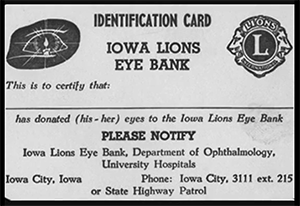
When Ruth Fisher reported to work in September 1955 at the newly-established Iowa Lions Eye Bank at University Hospital in Iowa City, there was no official office space. Dr. Alson E. Braley handed her a shoe box with office supplies and few instructions.
Fisher’s first order of business was to work with the Iowa Lions to design a registration card for eye donors. The first half of the card was filled out by a prospective donor, notarized, and returned to the eye bank. The bottom part remained with the donor, and they were instructed to tell their family members of their plans. Members of Lions Clubs of Iowa were enlisted to recruit their fellow residents to sign donor cards and suggest general rules and regulations for the operation of the eye bank. They also funded and placed enucleation kits in hospitals around the state.
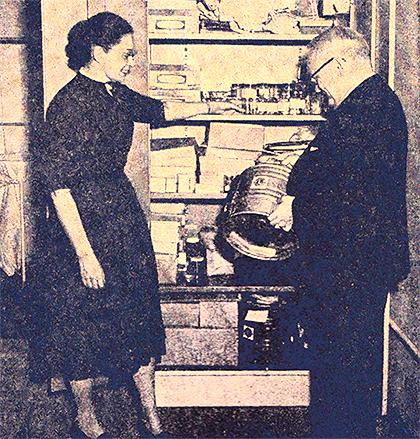
At the time of death, a licensed Iowa physician would remove the donor’s eyes and then call Iowa Lions Eye Bank to let them know the tissue was available. The physician would place the eyes into glass vials surrounded by wet ice in an aluminum thermos-like container. The eye bank would call the Iowa State Highway Patrol, which would send a trooper to pick up the container from the physician. The container would then be delivered to the eye bank at University Hospital in Iowa City.
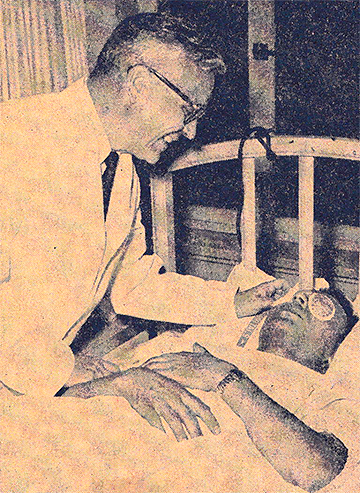
Fisher also developed a waiting list of those who needed cornea transplants. As eyes became available, Fisher would notify the recipient by phone that they would have to be at University Hospital within four hours.
In the early days of corneal transplantation, a patient would have to remain hospitalized and lay still for up to two weeks to prevent complications and potential rejection.
In addition to overseeing the operation of the eye bank, Fisher traveled around the state educating Iowans about the eye bank and encouraging them to sign donor cards. By the late 1980s, when they were phased out, more than 100,000 donor cards had been submitted to the eye bank.
Old Eye Bank Videos
In the early days of eye banking, there were significant challenges in ensuring a consistent and reliable supply of corneal tissue for transplant surgeries. By 1962, although several eye banks had been established and the Eye Bank Association of America had just been founded, it was particularly difficult to find tissue for emergency surgeries.
During an interview with James Beilman in 1977, Dr. Alson E. Braley, founder of Iowa Lions Eye Bank, said that in those days, in many instances, perforated corneas could only be repaired with a transplant.
“I’d had this man come in. He’d had a perforation of the cornea. I called every place trying to find an eye. They didn’t have one, so the poor man lost his eye.” –Dr. Alson Braley
Braley approached Ted Hunter, a member of the Iowa City Lions Club and fervent eye bank supporter. Both Braley and Hunter were amateur ham radio operators, and the two decided that radio could be utilized to bridge the gap between eye banks, hospitals, and surgeons across wide distances.
On December 20, 1962, Braley and Hunter established the Eye Bank Network to coordinate the exchange of donor eye tissue between 10 eye banks in the Midwest. At first, ham radio operators in Illinois, Indiana, Iowa, Missouri, Oklahoma, and Nebraska would tune in to the frequency 3970 at 7 a.m. six days a week, to see where tissue was available and which locations had an immediate need. They then would figure out how to transport that tissue by road or air.
The first cornea the Eye Bank Network placed was on Christmas Eve 1964 for a two-year-old girl in Oklahoma City who had fallen and injured her eye. Ham Radio Operator Travis Harris of Oklahoma City, who himself was blind, helped arrange for the transfer of the cornea from a Chicago-area hospital, and the operation was a success. Twenty-six years later, Braley was able to meet that girl in person.
In its first year of operation, the Eye Bank Network helped place 75 corneas for emergency transplants. Within eight years, 4,000 corneas had been distributed because of the Eye Bank Network.
The Eye Bank Network went off the air in 1992, after modern computing methods made the network obsolete. By this time, 11,000 corneas had been distributed due to the network.
Videos about Eye Net
